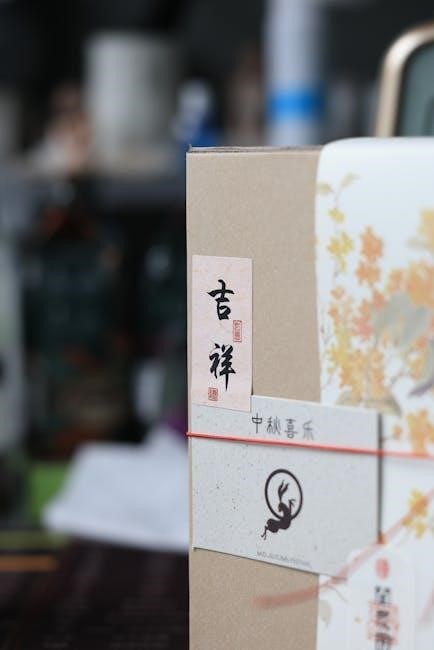The myth of Pandora’s Box is an enduring Greek tale exploring curiosity, consequences, and hope․ It recounts Pandora’s opening of a mysterious box, releasing evils into the world, while leaving hope behind as humanity’s solace․
1․1 Overview of the Myth
The story of Pandora’s Box is a timeless Greek myth that revolves around the first woman, Pandora, and a mysterious container she was forbidden to open․ Created by the gods, Pandora was gifted with curiosity and beauty but also tasked with guarding the box․ Despite warnings, her curiosity led her to open it, releasing all the evils of the world․ Only hope remained inside, offering humanity a glimmer of light amidst suffering․ This myth serves as a cautionary tale about curiosity, responsibility, and the duality of human nature․ Its enduring relevance continues to captivate audiences;
1․2 Historical Background and Origins
The myth of Pandora’s Box originates from ancient Greek mythology, with its earliest known accounts in Hesiod’s Works and Days (circa 8th or 7th century BCE)․ This story was used to explain the origin of evil and suffering in the world․ It reflects the cultural and philosophical ideas of the time, emphasizing the role of women and divine retribution․ The myth has since evolved, with interpretations varying across centuries, but its core message about human curiosity and consequences remains central to its narrative․ This story has become a cornerstone of Western cultural heritage․
1․3 Significance in Greek Mythology
The story of Pandora’s Box holds profound significance in Greek mythology as it explains the origin of evil and suffering in the world․ It serves as a cautionary tale about human curiosity and the consequences of divine wrath․ The myth also highlights the role of women in Greek culture, with Pandora often symbolizing the perceived dangers of femininity․ By addressing universal themes of morality and human nature, the story has become a cornerstone of Western cultural and philosophical thought, influencing literature, art, and even modern psychology․ Its enduring relevance underscores its importance․

The Story of Pandora’s Box

The story of Pandora’s Box is a cautionary tale about curiosity, divine punishment, and the origins of human suffering, shaping Western cultural narratives․
2․1 Pandora’s Creation and Purpose
Pandora was the first woman created by Hephaestus, the Greek god of fire, on Zeus’s command․ She was crafted as a punishment for humanity’s theft of fire by Prometheus․ Hephaestus shaped her from clay, infusing her with life and grace․ The gods endowed her with charm, beauty, and curiosity, making her irresistible․ Her purpose was to marry Epimetheus, Prometheus’s brother, and bring a mysterious box to Earth․ This box, sealed by Zeus, contained evils that would plague humanity, fulfilling the gods’ vengeance while introducing suffering to the world․
2․2 The Gift of the Box from Zeus
Zeus presented Pandora with a mysterious box, sealed and adorned, as a wedding gift when she married Epimetheus․ The box was crafted by Hephaestus and contained all the evils that would afflict humanity․ Zeus forbade Pandora from opening it, igniting her curiosity․ This gift was part of Zeus’s plan to punish humanity for accepting fire from Prometheus․ The box symbolized divine retribution, blending allure with danger, and served as a test of Pandora’s obedience and humanity’s resolve in resisting forbidden knowledge․
2․3 Pandora’s Curiosity and the Opening of the Box
Pandora’s insatiable curiosity eventually overcame her resolve․ Despite Zeus’s warning, she opened the box, releasing countless evils into the world, such as sorrow, disease, and greed․ As she realized her mistake, she hastily closed it, but the damage was done․ Only hope remained inside, offering humanity a glimmer of solace․ Her actions symbolized the human struggle with temptation and the unintended consequences of curiosity, forever altering the world’s fate․ This moment marked the beginning of human suffering, as evils spread across the earth․
2․4 The Release of Evils into the World
When Pandora opened the box, a multitude of evils escaped, including greed, envy, hatred, and disease, spreading across the world․ These evils plagued humanity, bringing suffering and chaos․ The release marked the end of an idyllic era, introducing pain and sorrow to human life․ The escape of these evils was irreversible, forever altering the world’s fate․ Pandora’s Box became a symbol of the unleashing of humanity’s darkest forces, leaving behind a legacy of struggle and enduring hardship․ This event is often seen as the origin of human suffering․
2․5 The Role of Hope in the Story
After releasing the evils, Pandora found hope remaining inside the box․ It served as a divine gift to humanity, offering comfort amidst suffering․ Hope symbolized resilience and the human capacity to endure adversity․ Unlike the evils, hope was not released but remained as a lasting source of strength․ It provided a glimmer of optimism, reminding people of better days ahead․ Hope became a crucial element in the story, balancing the darkness with the promise of a brighter future, making it a timeless and universal message of perseverance and faith․

Key Characters in the Myth
Pandora, the first woman, Zeus, the king of gods, Prometheus, the trickster, Epimetheus, Pandora’s husband, and Hephaestus, the creator, are central to the story․
3․1 Pandora: The First Woman
Pandora, created by Hephaestus, was the first woman in Greek mythology, crafted from clay to punish humanity․ Zeus gifted her to Epimetheus as a wife, intending her to unleash suffering․ Her curiosity led her to open the box, releasing evils into the world, leaving only hope behind․ Pandora symbolizes both divine punishment and the enduring power of hope, embodying the duality of human nature and the consequences of unchecked curiosity․
3․2 Zeus: The King of the Gods
Zeus, the supreme ruler of Mount Olympus, played a central role in the Pandora’s Box myth․ He orchestrated the creation of Pandora as punishment for Prometheus’s theft of fire․ Zeus’s cunning and authority drove the plot, as he presented Pandora to Epimetheus, ensuring the box’s eventual opening․ His actions highlighted his dual role as both a punisher and a ruler who maintained divine order․ Zeus’s decisions underscored his power and the inevitability of fate in Greek mythology, shaping the story’s tragic outcome and enduring legacy․
3․3 Prometheus and Epimetheus
Prometheus, a Titan, defied Zeus by stealing fire for humanity, while his brother Epimetheus accepted Pandora, despite warnings․ Prometheus’s daring act led to his eternal punishment, chaining him to a rock․ Epimetheus, though cautious, was deceived by Pandora’s charm, leading to the box’s opening․ Their contrasting traits—Prometheus’s rebellion and Epimetheus’s naivety—highlight the complexities of divine retribution and human fallibility, central to the myth’s moral framework and its exploration of consequence and free will․
3․4 Hephaestus: The Creator of Pandora
Hephaestus, the god of fire and blacksmith of the gods, was tasked by Zeus to create Pandora․ Known for his craftsmanship, Hephaestus shaped her from clay, infusing her with life and divine breath․ Often depicted as lame, Hephaestus imbued Pandora with beauty, charm, and cunning, adorning her with gifts from other gods․ His creation of the first woman was a pivotal act in Zeus’s plan to punish humanity․ Hephaestus’s role highlights his skill and the divine intent behind Pandora’s existence, showcasing his complex relationship with his creation․

Symbolism and Themes
The story explores themes of curiosity, forbidden knowledge, and the duality of hope and suffering, symbolizing humanity’s inherent flaws and the consequences of divine intervention․
4․1 The Box as a Symbol of Forbidden Knowledge
The box in Pandora’s story symbolizes forbidden knowledge, representing the idea that certain truths are meant to remain hidden․ Pandora’s curiosity drives her to open it, unleashing evils․ This act highlights humanity’s inherent desire to explore the unknown, often leading to unintended consequences․ The box serves as a metaphor for the dangers of unchecked curiosity and the idea that knowledge can be both empowering and destructive․ Its presence in the narrative underscores the tension between divine secrets and human inquiry․
4․2 Curiosity and Its Consequences
Pandora’s curiosity is a central theme in the myth, as it drives her to open the box despite Zeus’s warning․ Her actions illustrate the double-edged nature of curiosity, which can lead to both discovery and destruction․ The release of evils into the world serves as a cautionary tale about the dangers of unchecked curiosity․ However, it also highlights the inevitability of human inquiry, suggesting that curiosity, while risky, is an inherent part of human nature․ This duality adds depth to the myth’s moral message․
4․3 The Duality of Hope and Suffering
The myth of Pandora’s Box explores the duality of hope and suffering, presenting them as intertwined forces․ After unleashing evils upon the world, hope remains inside the box, offering humanity a glimmer of resilience․ This duality suggests that suffering and hope are inseparable, with hope acting as both a comfort and a potential torment․ The story highlights the human capacity to endure hardship while clinging to the promise of better times, emphasizing the complexity of emotional and existential balance in the face of adversity․
4․4 The Nature of Humanity
The story of Pandora’s Box reveals the complexities of human nature, highlighting both weakness and resilience․ Pandora’s curiosity symbolizes humanity’s inherent desire to explore and understand, often leading to unintended consequences․ The release of evils represents human frailty, while the presence of hope underscores humanity’s capacity for endurance and redemption․ This duality reflects the multifaceted nature of humans, balancing imperfection with the ability to persevere, making the myth a profound exploration of human character and its vulnerabilities․

Historical and Cultural Context
The myth of Pandora’s Box reflects ancient Greek societal values and fears, emphasizing curiosity and divine retribution․ It highlights the cultural significance of myths in explaining human suffering and the world’s imperfections․
5․1 The Role of Myths in Ancient Greek Society
In ancient Greece, myths like Pandora’s Box served as vital tools for explaining natural phenomena, moral lessons, and cultural values․ They were shared through oral traditions, theatre, and art, ensuring their widespread reach․ Myths taught citizens about right and wrong, fostering unity and identity․ Public storytellers, known as rhapsodes, performed these tales, making them accessible to all․ By linking human experiences to divine will, myths validated social hierarchies and laws, reinforcing order and stability in society․
5․2 The Evolution of the Story Over Time
The story of Pandora’s Box has evolved significantly over centuries, adapting to cultural and societal changes․ Originally recounted by Hesiod in ancient Greek literature, the myth was later influenced by Roman and Christian interpretations, which emphasized moral lessons․ During the Renaissance, the story gained artistic and literary attention, with the box becoming a central symbol․ Modern retellings often focus on psychological themes, such as curiosity and hope․ The narrative’s flexibility has allowed it to remain relevant across generations, reflecting changing human values and concerns․
5․3 The Mistranslation of “Pithos” to “Box”
The term “Pandora’s box” originates from a mistranslation of the Greek word pithos, meaning a large clay jar or container․ In Hesiod’s Works and Days, Pandora opens a pithos, not a box․ The error arose in the 16th century when the scholar Erasmus mistakenly translated pithos as “box․” This misinterpretation has persisted, altering the visual and symbolic understanding of the story․ The original pithos represented a storage vessel, while a box implies something smaller and more secretive, changing the narrative’s historical context․
5․4 The Influence of the Story on Western Culture
The story of Pandora’s Box has profoundly influenced Western culture, becoming a universal metaphor for unleashing unforeseen challenges․ It has inspired countless works of art, literature, and film, symbolizing the dangers of curiosity and the unpredictable nature of human actions․ The phrase “opening Pandora’s Box” is widely used to describe situations where a small action triggers widespread, irreversible consequences․ This myth has also shaped philosophical and psychological discussions about human nature, curiosity, and the complexities of hope and suffering․

Modern Interpretations and Retellings
Modern adaptations of Pandora’s Box explore themes like feminism, psychology, and technology, with literary reimaginations, artistic reinterpretations, and pop culture references, offering fresh perspectives on ancient myths․
6․1 Literary Adaptations
The story of Pandora’s box has inspired numerous literary adaptations across genres․ Classical works, such as Hesiod’s Theogony, laid the foundation, while modern authors reinterpret the myth in novels, poems, and plays․ John Milton’s Paradise Lost draws parallels with Pandora’s curiosity and Eve’s temptation․ Contemporary writers often explore themes of curiosity, hope, and humanity’s flaws․ These adaptations breathe new life into the ancient tale, making it resonate with diverse audiences while maintaining its timeless essence․ Literary reinterpretations highlight the myth’s enduring relevance in exploring human nature and moral dilemmas․
6․2 Artistic Representations
Artistic representations of Pandora’s Box have captivated audiences for centuries, offering visual interpretations of the myth․ Paintings often depict Pandora as a curious figure, surrounded by symbolic elements like the box and escaping evils․ Sculptures, too, have immortalized her story, focusing on her emotional expressions․ Digital art and modern installations reinterpret the myth, blending traditional themes with contemporary styles․ These artworks not only preserve the story but also invite reflection on its timeless themes, making Pandora’s Box a enduring subject in visual art․
6․3 Pop Culture References
Pandora’s Box has inspired numerous pop culture references, symbolizing forbidden knowledge or uncontrollable forces․ In films like Pandora’s Box (1929) and Pandora (2016), the myth is reimagined with modern twists․ TV shows such as Supernatural feature characters named Pandora, embodying the duality of hope and chaos․ Music artists like Cocteau Twins reference the myth in songs, while video games use the box as a plot device․ These adaptations reflect the timeless appeal of the story, often linking it to themes of curiosity, power, and the consequences of human actions․ Its imagery persists as a cultural metaphor for risky exploration․
6․4 Psychological and Philosophical Analysis
The story of Pandora’s Box offers profound psychological insights, particularly through the lens of curiosity and human frailty․ Freudian analysis might view the box as a symbol of the unconscious, with Pandora’s act representing the inevitable confrontation with repressed desires and fears․ Philosophically, the myth explores existential themes of freedom and responsibility, highlighting humanity’s inherent tendency toward both creation and destruction․ The duality of hope and suffering emerges as a central paradox, mirroring the human condition’s complexity․ This narrative continues to inspire reflections on morality, choice, and the enduring struggle between light and darkness․

Lessons and Morals from the Story
The story of Pandora’s Box teaches the dangers of unchecked curiosity, the consequences of human actions, the power of hope, and the complexity of human nature․
7․1 The Dangers of Unchecked Curiosity
The story of Pandora’s Box underscores the peril of unchecked curiosity, a theme that resonates deeply in human experience․ Pandora’s inability to resist opening the box, despite warnings, illustrates how curiosity, when unguided by wisdom, can lead to devastating consequences․ This serves as a cautionary tale about the importance of self-control and the potential risks of seeking knowledge without understanding its implications․ The myth highlights the delicate balance between curiosity as a driving force for progress and its capacity to unleash harm when not tempered by prudence․
7․2 The Consequences of Human Actions
The story of Pandora’s Box underscores the profound consequences of human actions, emphasizing the idea that decisions, once made, cannot be undone․ Pandora’s curiosity led to the release of evils into the world, forever altering humanity’s fate․ This serves as a cautionary tale about the repercussions of unchecked actions and the importance of responsibility․ The myth highlights how even well-intentioned individuals can unleash unintended suffering, illustrating the delicate balance between free will and the consequences that follow․
7․3 The Power of Hope
In the story of Pandora’s Box, hope emerges as the last entity remaining inside, offering humanity a glimmer of resilience․ After unleashing suffering, hope provides comfort, suggesting that even in despair, there is potential for redemption․ This duality highlights hope’s complex role—it can be both a source of strength and a bittersweet reminder of enduring hardships․ The myth underscores hope’s power to sustain humanity, making it a timeless and universal message about perseverance and the human spirit’s capacity to endure adversity․
7․4 The Complexity of Human Nature
The story of Pandora’s box highlights the intricate duality of human nature, showcasing both curiosity and caution, hope and despair․ Pandora, as the first woman, embodies humanity’s capacity for both good and evil․ Her actions illustrate the internal conflict between obedience and curiosity, reflecting the universal human struggle with temptation․ This myth underscores the idea that human nature is multifaceted, containing both positive and negative traits․ It serves as a reminder to embrace this complexity while striving for balance and self-awareness in our choices and actions․

The Myth in Comparative Context
The story of Pandora’s Box shares themes with myths from other cultures, such as forbidden knowledge and human curiosity, reflecting universal moral lessons․
8․1 Similar Stories in Other Cultures
Several cultures have myths resembling Pandora’s Box, exploring themes of forbidden knowledge and unintended consequences․ In Norse mythology, the trickster Loki’s mischief often leads to chaos, mirroring Pandora’s curiosity․ Similarly, the story of Eve in the Bible involves a forbidden act that brings suffering․ In Chinese mythology, the goddess Nuwa seals a box containing evils, echoing the duality of hope and despair․ These parallels highlight humanity’s universal fascination with the consequences of curiosity and the nature of evil․
8․2 The Story’s Universality
The tale of Pandora’s Box transcends cultural boundaries, resonating with universal themes of curiosity, consequence, and hope․ Its core message about the duality of human nature—capable of both good and evil—connects with audiences across time and space․ The story’s exploration of forbidden knowledge and the unpredictability of human actions speaks to fundamental questions about morality and existence․ Its enduring appeal lies in its ability to evoke emotions like fear, regret, and optimism, making it a timeless narrative in global mythology․
8․3 The Role of the “Forbidden Object” in Myths
In myths worldwide, the “forbidden object” serves as a symbolic catalyst for transformative events, often representing knowledge, power, or divine secrets․ These objects, like Pandora’s box, are designed to test human resolve and curiosity, leading to profound consequences․ They embody the tension between obedience and exploration, highlighting the complexities of human nature․ The forbidden object’s presence in various cultures underscores its universal appeal, as it challenges characters to confront their desires and the unknown, ultimately shaping the course of their destinies and the world around them․
8․4 The Concept of Suffering and Evil
The story of Pandora’s Box explores the origin of suffering and evil in the world, presenting them as inevitable aspects of human existence․ By releasing the evils, the myth explains why humanity faces pain, disease, and hardship; This narrative reflects ancient Greek beliefs about the nature of life and the balance between good and evil․ The presence of hope, however, offers a counterbalance to the darkness, suggesting that even in suffering, there is a glimmer of resilience and optimism․ This duality underscores the complexity of human experience․

The Story’s Relevance Today
The myth of Pandora’s Box remains a timeless allegory, cautioning against unchecked curiosity and the unintended consequences of human innovation, resonating in modern debates on technology, ethics, and environmental sustainability․
9․1 The Metaphorical Meaning of Pandora’s Box
Pandora’s Box is often seen as a metaphor for the unpredictable nature of human curiosity and the consequences of unchecked actions․ It symbolizes the idea that some knowledge or forces, once released, cannot be contained․ The box represents the duality of hope and suffering, where even amidst chaos, a glimmer of positivity remains․ In modern contexts, it serves as a cautionary tale about the risks of tampering with unknown or powerful forces, whether technological, societal, or personal․ Its metaphorical significance underscores the delicate balance between curiosity and caution in human endeavors․
9․2 The Story’s Impact on Modern Thought
The story of Pandora’s Box has profoundly influenced modern thought, particularly in science, ethics, and philosophy․ It serves as a cautionary tale about the consequences of human curiosity and the dangers of unchecked innovation․ The metaphor of the box is often used to discuss emerging technologies, such as genetic engineering or artificial intelligence, where opening “Pandora’s Box” could unleash uncontrollable forces․ This myth also reflects humanity’s dual nature, balancing hope with the potential for destruction, resonating deeply in contemporary debates about progress and responsibility․
9․3 The Myth’s Enduring Appeal
The story of Pandora’s Box remains a timeless tale due to its universal themes and relatable human emotions․ Its exploration of curiosity, hope, and the duality of good and evil resonates across cultures and generations․ The myth’s adaptability to various retellings in literature, art, and popular culture further cements its appeal․ It continues to inspire philosophical debates about human nature and the consequences of actions․ This enduring relevance ensures Pandora’s Box remains a captivating and thought-provoking narrative in modern times․
9․4 The Story’s Educational Value
The story of Pandora’s Box offers valuable educational lessons, making it a timeless teaching tool․ It highlights the importance of critical thinking, as Pandora’s curiosity leads to significant consequences․ The myth encourages discussions about ethics, responsibility, and the impact of human actions․ Additionally, it fosters empathy by exploring the duality of hope and suffering․ Educators use this narrative to teach moral dilemmas, promoting deeper reflection on human nature and decision-making․ Its universal themes make it a powerful resource for character development and cultural understanding․
The story of Pandora’s Box remains a timeless allegory, reflecting humanity’s inherent curiosity and the duality of hope amidst suffering․ Its enduring relevance underscores the complexity of human nature and the consequences of actions, offering universal lessons that transcend time and culture․
10․1 Summary of Key Points
The story of Pandora’s Box is a timeless Greek myth exploring human curiosity, consequences, and hope․ Pandora, the first woman, was created by Hephaestus and given a box by Zeus with strict orders not to open it․ Driven by curiosity, she unleashed evils into the world, leaving hope as the sole remaining force․ This myth symbolizes the duality of human nature, the dangers of unchecked curiosity, and the enduring power of hope․ Its themes resonate across cultures, making it a profound allegory for humanity’s struggles and aspirations․
10․2 Final Thoughts on the Myth’s Significance
The story of Pandora’s Box remains a timeless allegory, offering profound insights into human nature, curiosity, and the duality of hope and suffering․ Its enduring appeal lies in its universality, transcending cultures and centuries․ The myth serves as a cautionary tale about the consequences of unchecked curiosity and the inevitability of hardship, yet it also highlights the resilience of hope․ Pandora’s Box is not just a myth but a reflection of humanity’s complexities, making it a powerful tool for introspection and moral guidance in both ancient and modern contexts․
